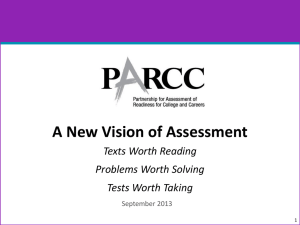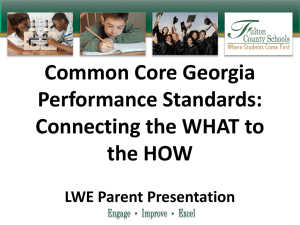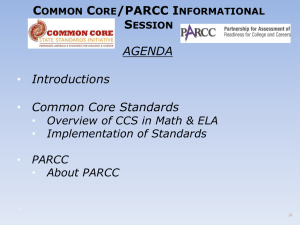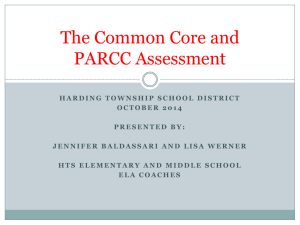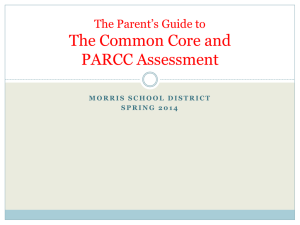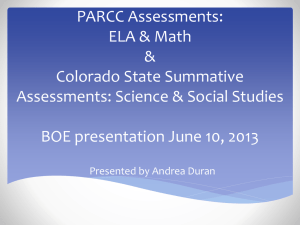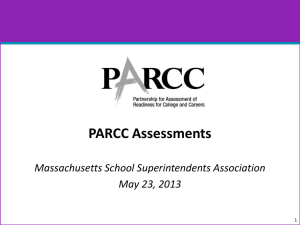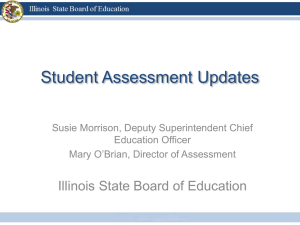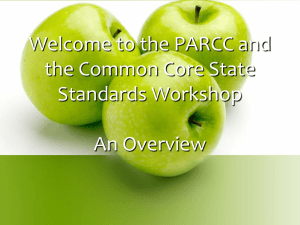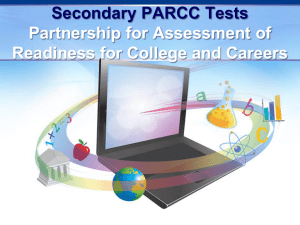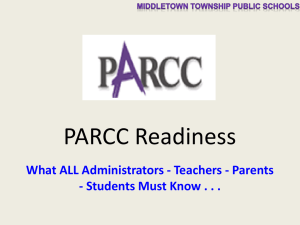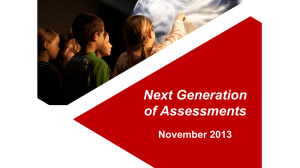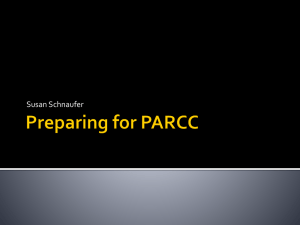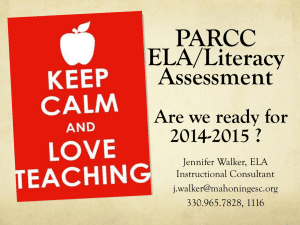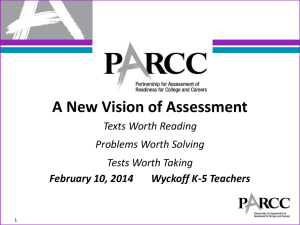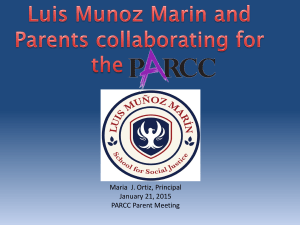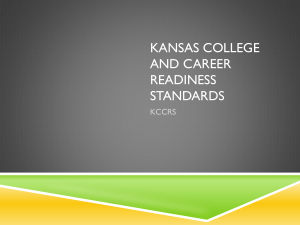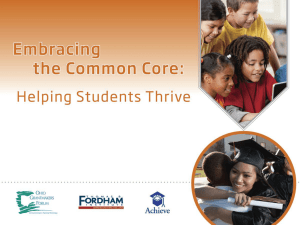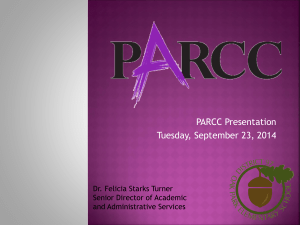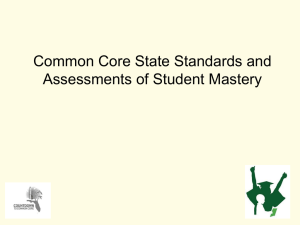view the Common Core Parent Workshop Presentation
advertisement
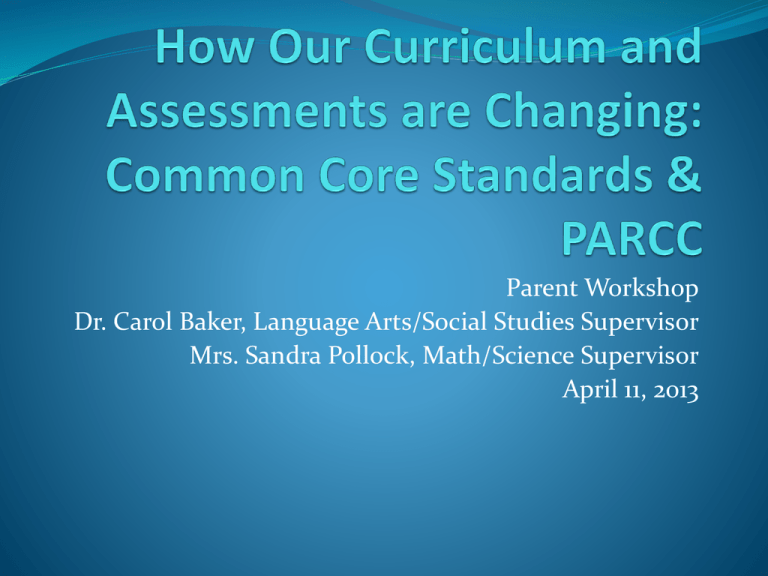
Parent Workshop Dr. Carol Baker, Language Arts/Social Studies Supervisor Mrs. Sandra Pollock, Math/Science Supervisor April 11, 2013 Common Core Standards National Governor’s Association (NGA) and Council of Chief State School Officers (CCSSO) Voluntary Fewer, clearer and higher Adopted by NJ in June 2011 Implementation in NJ 2011-2012- K-2 Mathematics 2012-2013- K-12 ELA 3-5, HS Mathematics 2013-2014- 6-8 Mathematics States that Have Adopted the CCS Key Advances of the Common Core MATHEMATICS Focus, coherence and clarity: emphasis on key topics at each grade level and coherent progression across grades Procedural fluency and understanding of concepts and skills Promote rigor through mathematical proficiencies that foster reasoning and understanding across discipline High school standards organized by conceptual categories ENGLISH LANGUAGE ARTS/LITERACY Balance of literature and informational texts; focus on text complexity Emphasis on argument, informative/ explanatory writing, and research Speaking and listening skills Literacy standards for history, science and technical subjects ELA Standards for the Content Area Grades 6-12 Reading- text support, central ideas, text organization, visual information, fact-opinion-judgment, primary and secondary sources Writing- argument & informative/explanatory Research- short projects, devising a research question, using multiple sources- digital and print, determining accuracy of sources Overview of the Common Core http://vimeo.com/51933492 Common Core Shifts for Language Arts 1. Building knowledge through content-rich nonfiction. 2. Reading, writing, and speaking grounded in evidence from the text, both literary and informational. 3. Regular practice with complex text and its academic language. Common Core Shifts for Math 1. Focus strongly where the Standards focus. 2. Coherence: think across grade levels, and link to major topics within grades. 3. Rigor: in major topics pursue: Conceptual understanding Procedural skill Fluency and application with equal intensity Key Points in Math Standards More stress on conceptual understanding, but still stress on procedural skill- Conceptual understanding is keyMust learn traditional algorithms High school standards include more application of mathematics to real world situations Number sense is emphasized in K-5 Algebra is embedded in number sense until Gr. 6 Less expected in statistics and probability early; more in later grades Geometry in every grade, but limited in scope in K-8 Some topics change grades from NJCCCS Key Points in Math Standards K- 2 Focus Number Sense Gr. 3-5 Focus Multiples, fractions, and factors Gr. 6 Focus Proportional Reasoning Gr. 7-8 Minimal changes from New Jersey Standards Ratio and proportional reasoning Grade 8- Linear Algebra Key Points in Math Standards High School Focus Clearly defined for Algebra, Geometry and other subjects Algebra I 3 Critical Areas Formulating and reasoning about expressions and equations Grasping concept of functions and using functions to describe quantitative relationships Analyzing 2 and 3 dimensional space and figures using distance, angle, similarity, and congruence and applying the Pythagorean Theorem Key Points in ELA Standards Reading Classic and contemporary literature, including myths and folktales Increase in nonfiction texts- subject area topics Understanding of complex texts Close reading of texts Writing Argument/Opinions – claims, counterclaims, sound reasoning, supporting opinions- begins as persuasion in earlier grades Research- several short, focused research projects per year Key Points in ELA Standards Speaking and Listening Greater emphasis on speaking and listening – one-to-one, small group and whole class discussion Students gain and evaluate information using listening skills Language More emphasis on vocabulary- Academic vocabulary is key Standards clearly list specific language skills Media and Technology Integrated throughout strands Areas of Assessment in ELA Reading Complex Texts Range of grade-level texts, including content-area domains Vocabulary is a key component in each passage Close, analytic reading and comparing and synthesizing ideas across texts are required Writing Effectively When using and/or Analyzing Sources Activities require reading, gathering evidence, and analyzing and presenting evidence in writing Areas of Assessment in ELA Conducting and Reporting on Research Tasks require gathering resources, evaluating the relevance of the sources, and reporting on the ideas Speaking and Listening Range of interactive oral and communication skills Skills include making formal presentations, working collaboratively, sharing findings, and listening carefully to others Language Use for Reading, Writing, and Speaking Strong command of grammar and spoken and written academic English Partnership for Assessment of Readiness for College and Career (PARCC) 16 PARCC Goals 1. 2. 3. 4. 5. 6. Create high quality assessments Build a pathway to college and career readiness for all students Support educators in the classroom Develop 21st century, technology-based assessments Advance accountability at all levels Build an assessment that is sustainable and affordable PARCC Assessments Four Components: Two Summative, Required Components: Make “college and career readiness” and “on-track” determinations Measure the full range of standards and full performance continuum Provide data for accountability uses, including measures of growth PARCC Assessments Four Components, continued Two Non-summative, Optional Assessments Generate timely information for informing instruction, interventions, and professional development during the school year An additional third non-summative component will assess students’ speaking and listening skills PARCC Assessment Components Summative Assessment Components: Performance-Based Assessment (PBA) administered as close to the end of the school year as possible. The ELA/Literacy PBA will focus on writing effectively while analyzing text. The mathematics PBA will focus on applying skills, concepts, and understandings to solve multi-step problems requiring abstract reasoning, precision, perseverance, and strategic use of tools. End-of –Year Assessment (EOY) administered after approximately 90% of the school year. The ELA/Literacy EOY will focus on reading comprehension. The math EOY will be comprised of innovative, machine-scorable items. PARCC Assessment Components Non-Summative Assessment Components Diagnostic Assessment designed to be an indicator of student knowledge and skills so that instruction, supports, and professional development can be tailored to meet students’ needs. Mid-Year Assessment comprised of performancebased items and tasks, with an emphasis on hard-tomeasure standards. After study, individual states may consider including as a summative component. PARCC Assessment The PARCC assessments will allow us to make important claims about students’ knowledge and skills. In ELA/Literacy , whether students: Can read and comprehend complex literary and informational text Can write effectively when analyzing text Have attained overall proficiency in ELA/Literacy In Mathematics, whether students: Have mastered knowledge and skills in highlighted domains (e.g. domain of highest importance for a particular grade level- number/fractions in Gr. 4) Have attained overall proficiency in mathematics NJASK and PARCC PARCC will be administered in the spring of 2015 “Transitional” NJASK will be utilized by NJ in 2013 and 2014 Transitional NJASK will measure the Common Core State Standards (CCSS) within the current NJASK format/blueprint Transitional because NJASK cannot measure all of the CCSS NJ reviewed test bank items and will use the items that have the depth and rigor associated with the CCSS NJ field tested some items in 2012 for use in 2013 (did not count toward students’ scores) Shift in ELA Transition to Common Core For reading and writing tasks, students are expected to ground their responses in specific evidence and information in the texts they have read, film or shows they have viewed, or facts learned in science and social studies. Students are not to “invent” information except when writing narratives. Students are expected to cite evidence from the text. All passages require students to read and comprehend at the higher end of text complexity for their grade level. Students are expected to comprehend and use grade-appropriate general vocabulary and domain-specific words in their reading and writing. The scoring of constructed-responses in both reading and writing will reflect the degree to which students refer to or incorporate text-based ideas and information. Shift in Math Transition to Common Core Connecting Content Standards and Mathematical Practices 1. Make sense of problems and persevere in solving them. 2. Reason abstractly and quantitatively. 3. Construct viable arguments and critique the reasoning of others. 4. Model with mathematics. 5. Use appropriate tools strategically. 6. Attend to precision. 7. Look for and make use of structure. 8. Look for and express regularity in repeated reasoning PARCC Model Content Frameworks Purposes To support implementation of the Common Core Standards To inform the development of item specifications and plans for the PARCC assessments Content Frameworks Emphasis on shared responsibility within schools; All subjects require reading, writing, and communicating about ideas at a complex level What are we doing? Teachers have read and discussed Common Core Standards Curriculum is aligned to Common Core Standards Professional Development is focused on strategies for implementing the Common Core Standards and helping students achieve the rigor of the standards Benchmark assessments are being reviewed and revised to align to Common Core Materials and resources added to meet the content and rigor of the Common Core Standards Interdisciplinary project work- Benchmark assessments that align to multiple content/subject area standards Sources for Power Point Common Core Standards- http://www.corestandards.org/ Council of the Great City Schools- http://www.cgcs.org/Page/1 New Jersey Department of Educationhttp://www.state.nj.us/education/ NJASK Transitional PowerPoint- October 2012 PARCC- http://www.parcconline.org/ The Partnership for Assessment of Readiness for College and Careers Power Point- February 2013 PARCC- A New Vision of Assessment- Power Point - March 2013

